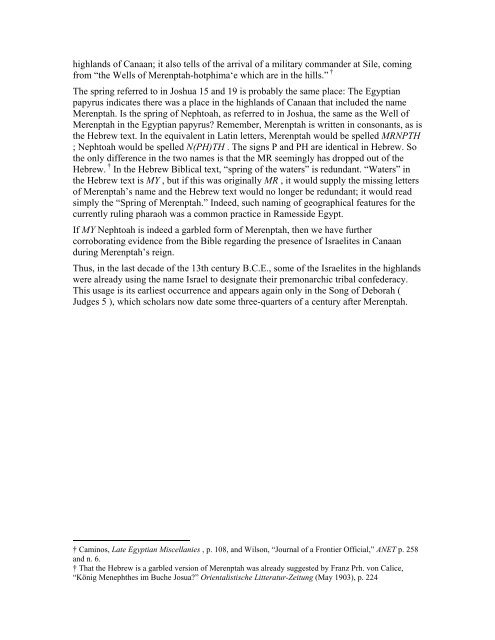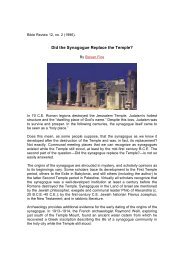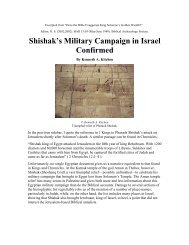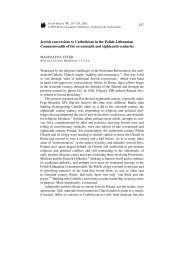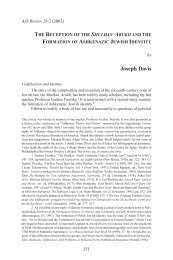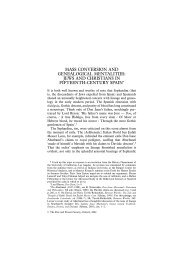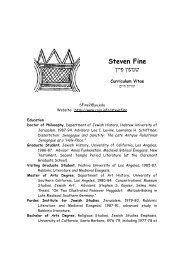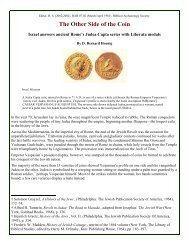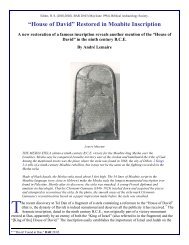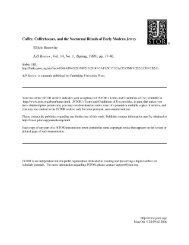3200-Year-Old Picture of Israelites Found in Egypt
3200-Year-Old Picture of Israelites Found in Egypt
3200-Year-Old Picture of Israelites Found in Egypt
Create successful ePaper yourself
Turn your PDF publications into a flip-book with our unique Google optimized e-Paper software.
highlands <strong>of</strong> Canaan; it also tells <strong>of</strong> the arrival <strong>of</strong> a military commander at Sile, com<strong>in</strong>g<br />
from “the Wells <strong>of</strong> Merenptah-hotphima‘e which are <strong>in</strong> the hills.” †<br />
The spr<strong>in</strong>g referred to <strong>in</strong> Joshua 15 and 19 is probably the same place: The <strong>Egypt</strong>ian<br />
papyrus <strong>in</strong>dicates there was a place <strong>in</strong> the highlands <strong>of</strong> Canaan that <strong>in</strong>cluded the name<br />
Merenptah. Is the spr<strong>in</strong>g <strong>of</strong> Nephtoah, as referred to <strong>in</strong> Joshua, the same as the Well <strong>of</strong><br />
Merenptah <strong>in</strong> the <strong>Egypt</strong>ian papyrus? Remember, Merenptah is written <strong>in</strong> consonants, as is<br />
the Hebrew text. In the equivalent <strong>in</strong> Lat<strong>in</strong> letters, Merenptah would be spelled MRNPTH<br />
; Nephtoah would be spelled N(PH)TH . The signs P and PH are identical <strong>in</strong> Hebrew. So<br />
the only difference <strong>in</strong> the two names is that the MR seem<strong>in</strong>gly has dropped out <strong>of</strong> the<br />
Hebrew. † In the Hebrew Biblical text, “spr<strong>in</strong>g <strong>of</strong> the waters” is redundant. “Waters” <strong>in</strong><br />
the Hebrew text is MY , but if this was orig<strong>in</strong>ally MR , it would supply the miss<strong>in</strong>g letters<br />
<strong>of</strong> Merenptah’s name and the Hebrew text would no longer be redundant; it would read<br />
simply the “Spr<strong>in</strong>g <strong>of</strong> Merenptah.” Indeed, such nam<strong>in</strong>g <strong>of</strong> geographical features for the<br />
currently rul<strong>in</strong>g pharaoh was a common practice <strong>in</strong> Ramesside <strong>Egypt</strong>.<br />
If MY Nephtoah is <strong>in</strong>deed a garbled form <strong>of</strong> Merenptah, then we have further<br />
corroborat<strong>in</strong>g evidence from the Bible regard<strong>in</strong>g the presence <strong>of</strong> <strong>Israelites</strong> <strong>in</strong> Canaan<br />
dur<strong>in</strong>g Merenptah’s reign.<br />
Thus, <strong>in</strong> the last decade <strong>of</strong> the 13th century B.C.E., some <strong>of</strong> the <strong>Israelites</strong> <strong>in</strong> the highlands<br />
were already us<strong>in</strong>g the name Israel to designate their premonarchic tribal confederacy.<br />
This usage is its earliest occurrence and appears aga<strong>in</strong> only <strong>in</strong> the Song <strong>of</strong> Deborah (<br />
Judges 5 ), which scholars now date some three-quarters <strong>of</strong> a century after Merenptah.<br />
† Cam<strong>in</strong>os, Late <strong>Egypt</strong>ian Miscellanies , p. 108, and Wilson, “Journal <strong>of</strong> a Frontier Official,” ANET p. 258<br />
and n. 6.<br />
† That the Hebrew is a garbled version <strong>of</strong> Merenptah was already suggested by Franz Prh. von Calice,<br />
“König Menephthes im Buche Josua?” Orientalistische Litteratur-Zeitung (May 1903), p. 224


